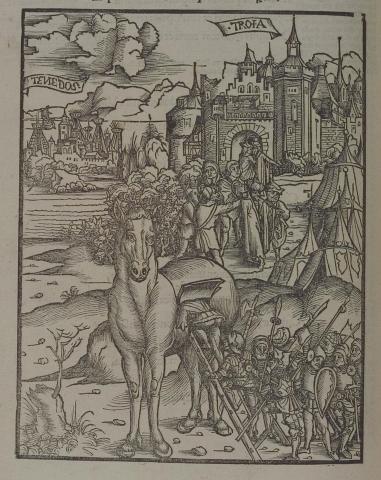Annotations
In this image, the Greeks are setting up the trap of the Trojan Horse. In the foreground, Greek warriors, selected for their strength and courage, climb up into a wooden horse that the Greeks have built (13-20). In the background, to the left, the Greek ships have sailed away to Tenedos to hide, so that the Trojans think they have left (21-25). To the right is the city of Troy, which sets the scene. Outside the city, in the middle ground, a group of Trojans wonder at the abandoned Greek tents (26-8). (Katy Purington)
Woodcut illustration from the “Strasbourg Vergil,” edited by Sebastian Brant: Publii Virgilii Maronis Opera cum quinque vulgatis commentariis expolitissimisque figuris atque imaginibus nuper per Sebastianum Brant superadditis (Strasbourg: Johannis Grieninger, 1502), fol. 156v, executed by an anonymous engraver under the direction of Brant.


Sebastian Brant (1458–1521) was a humanist scholar of many competencies. Trained in classics and law at the University of Basel, Brant later lectured in jurisprudence there and practiced law in his native city of Strasbourg. While his satirical poem Das Narrenschiff won him considerable standing as a writer, his role in the transmission of Virgil to the Renaissance was at least as important. In 1502 he and Strasbourg printer Johannes Grüninger produced a major edition of Virgil’s works, along with Donatus’ Life and the commentaries of Servius, Landino, and Calderini, with more than two hundred woodcut illustrations. (Annabel Patterson)